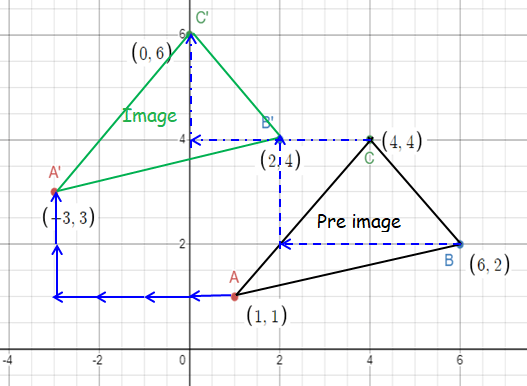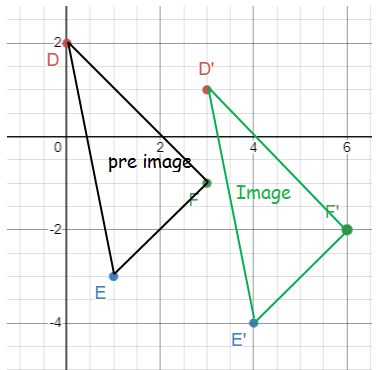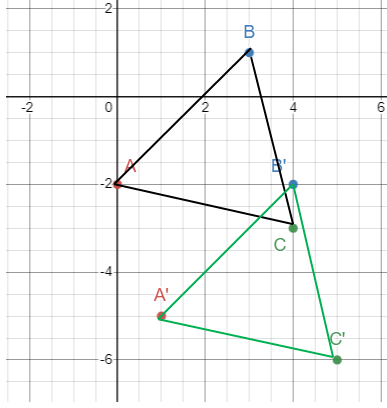TRANSLATING POINTS ON A COORDINATE PLANE
Subscribe to our ▶️ YouTube channel 🔴 for the latest videos, updates, and tips.
Translation: a “slide” of the figure -every point shifts the same distance, in the same direction
Another way of notating a translation is with a capital
T : RULE: T a,b (x , y) => (x + a , y + b)
A translation is transformation in which every point of figure moves a fixed distance in a given direction.
- Number of units of horizontal movements can be considered as "x".
- Number of units of vertical movements can be considered as "y".
- Translation vector will be in the form (x, y)
- If x is positive, then we have to move x units to the right→
- If x is negative, then we have to move x units to the left ←.
- If y is positive, then we have to move y units up ↑ .
- If y is negative, then we have to move y units down ↓.
Problem 1 :
a. On the graph, draw and label ΔABC, whose vertices have the coordinates A(1 , 1), B(6 , 2), and C(4 , 4).
b. Under the translation (x , y) -->(x - 4, y + 2), on the same graph, draw and label ΔA`B`C`.
c. Map the Translation
A(1 , 1) -->
B(6 , 2) -->
C(4 , 4) -->
Solution :
a) & b)

c)
A (1 , 1) --> A' (1 - 4, 1 + 2) ==> A'(-3, 3)
B (6 , 2) --> B' (6 - 4, 2 + 2) ==> B'(2, 4)
C (4 , 4) --> C' (4 - 4, 4 + 2) ==> C'(0, 6)
Problem 2 :
Graph the original triangle and the image of ΔDEF under the translation T3 , -1.
b. Rewritten as:
c. Map the translation:
D(0 , 2)
E(1 , -3)
F(3 , -1)
Solution :

c) D(0 , 2) --> D' (0+3, 2-1) ==> D'(3, 1)
E(1 , -3) --> E' (1+3, -3-1) ==> E'(4, -4)
F(3 , -1) --> F' (3+3, -1-1) ==> F'(6, -2)
Problem 3 :
Rewrite the translation in a different form:
a. T-2, 5 __________
b. (x, y) --> (x + 4, y – 1) - ___________
Solution :
a. T-2, 5 --> (x - 2, y + 5)
b. (x, y) --> (x + 4, y – 1) --> T4, -1
Problem 4 :
Does the image remain congruent after a translation? Explain your answer.
Solution :
Translation of point means, shifting the point from one place to other. So, the size of the image will not be changed. Then the image will remain congruent.
Problem 5 :
The rule for the translation so the image of A is A` is:
A(2 , 5) --> A`(-1 , 1)
a) T1, -4 b) T-3 , -4 c) T3, 4 d) T-1,4
Solution :
Option a :
A(2 , 5) --> A`(2 + 1, 5 - 4) ==> A'(3, 1)
Option b :
A(2 , 5) --> A`(2 - 3, 5 - 4) ==> A'(-1, 1)
So, option b is correct.
Problem 6 :
Which point is the image of P(4 , -3) under the translation
P(x , y) --> `(x - 4, y) ?
a) P`(-8 , 0) b) P` (8 , -3) c) P`(0 , -3) d) P`(0 , 0)
Solution :
Original point is P(4, -3). This point is to be translated to 4 units left and no vertical translation.
P(4, -3) ==> P' (4 - 4, -3 - 0) ==> P'(0, -3)
Problem 7 :
Find the image of with the given translation rule.
T2 , -3
H (-2, 0) -->
O(0 , 0) -->
T (0 , 4) -->
Solution :
H (-2, 0) --> H' (-2 + 2, 0 - 3) ==> H'(0, -3)
O(0 , 0) --> O' (0 + 2, 0 - 3) ==> O'(2, -3)
T (0 , 4) --> T' (0 + 2, 4 - 3) ==> T'(2, 1)
Problem 8 :
The coordinates of ΔABC are
A(0 , -2), B(3 , 1), and C(4 , -3).
Graph and label these points.
b. Under the translation (x , y) --> (x +1, y - 3), draw and label ΔA`B`C`.
c. Map the Translation
Solution :
A(0 , -2) --> A'(0 + 1, -2 - 3) ==> A'(1, -5)
B(3 , 1) --> B'(3 + 1, 1 - 3) ==> B'(4, -2)
C(4 , -3) --> C'(4 + 1, -3 - 3) ==> C'(5, -6)

Problem 9 :
Map the translation of ΔBUG under the rule given below.
T-2 , 4
B(-2 , -3) --->
U(1 , 0) ---->
G(3 , -4) --->
Solution :
B(-2 , -3) ---> B' (-2 - 2, -3 + 4) ==> B' (-4, 1)
U(1 , 0) ---> U' (1 - 2, 0 + 4) ==> U' (-1, 4)
G(3 , -4) ---> G' (3 - 2, -4 + 4) ==> G' (1, 0)
Problem 10 :
Which of the following is the rule of the translation in which every point moves 6 units to the right on a graph?
a) (x , y) --> (x , y + 6) b) (x , y) -->(x +6, y)
c) (x , y) --> (x +6, y + 6) d) (x , y) -->(x -6, y)
Solution :
Observing option b, the value of x moved right 6 units and there is no change vertically. So, the answer is
(x , y) -->(x +6, y)
Problem 11 :
Which quadrant does the point (-2, 4) lie in?
Solution :
(-2, 4) looks like (-x, y)
So, it lies in the second quadrant.
Subscribe to our ▶️ YouTube channel 🔴 for the latest videos, updates, and tips.
Recent Articles
-
Finding Range of Values Inequality Problems
May 21, 24 08:51 PM
Finding Range of Values Inequality Problems -
Solving Two Step Inequality Word Problems
May 21, 24 08:51 AM
Solving Two Step Inequality Word Problems -
Exponential Function Context and Data Modeling
May 20, 24 10:45 PM
Exponential Function Context and Data Modeling